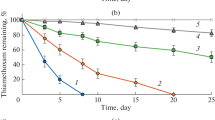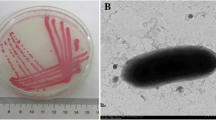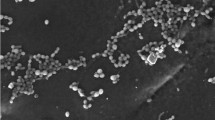Abstract
A fungal strain capable of utilizing chlorpyrifos as sole carbon and energy sources was isolated from soil by enrichment cultivation approach. The half-lives of degradation (DT50) for chlorpyrifos at concentrations of 1, 10, and 100 mg l−1 by the fungal strain DSP in mineral salt medium were measured to be 2.03, 2.93, and 3.49 days, respectively. Two cell-free extracts [E (1:10) and E (1:20)] from the fungal strain DSP in bran–glucose medium were prepared and used to enhance chlorpyrifos degradation on vegetables. Compared with the controls, the DT50 of chlorpyrifos were reduced by 70.3%, 65.6%, 80.6%, 80.6%, and 86.1%, and by 53.8%, 43.2%, 66.0%, 54.3%, and 67.7% on E (1:20) and E (1:10) treated pakchoi, water spinach, Malabar spinach, haricot beans, and pepper, respectively. The 7-day residual values (R 7) of chlorpyrifos on E (1:10) treated vegetables were all lower than the corresponding maximum residue levels of European Union (EU MRLs), except that the R 7 value on haricot beans was slightly higher than the corresponding EU MRLs. The results indicate that cell-free extracts could rapidly degrade chlorpyrifos residues on vegetables.
Similar content being viewed by others
References
Aguilera-del Real A, Valverde-García, Camacho-Ferre F, (1999) Behavior of methamidophos residues in peppers, cucumbers, and cherry tomatoes grown in a greenhouse: evaluation by decline curves. J. Agric. Food Chem. 47: 3355–3358
Ahren D, Ursing BM, Tunlid A, (1998) Phylogeny of nematode-trapping fungi based on 18S rDNA sequences FEMS Microbiol. Lett. 158: 179–184
Barnett HL, Hunter BB, (1972) Illustrated Genera of Imperfect Fungi 3rd edition. Burgess Publishing Company Minnesota, USA
Brown KA, (1980) Phosphotriesterases of Flavobacterium sp. Soil Biol. Biochem. 12: 105–112
Bolognesi C, Morasso G, (2000) Genotoxicity of pesticides: potential risk for consumers Trends Food Sci. Technol. 11: 182–187
Chen W, Mulchandani A, (1998) The use of live biocatalysts for pesticide detoxification Trends Biotechnol. 16: 71–76
Cochran RC, Kishiyama J, Aldous C, Carr Jr WC, Pfeifer KF, (1995) Chlorpyrifos: hazard assessment based on a review of the effects of short-term and long-term exposure in animals and humans Food Chem. Toxicol. 33: 165–172
Dai FL, (1987) Morphology and Taxonomy of Fungi Science Press, Beijing, China
Dave KI, Miller CE, Wild JR, (1993) Characterization of organophosphorus hydrolases and the genetic manipulation of the phosphotriesterase from Pseudomonas diminuta Chem. Biol. Interact. 8: 55–68
Fan AM, Jackson RJ, (1989) Pesticides and food safety Regul. Toxicol. Pharm. 9: 158–174
Gajbhiye VT, Gupta S, Gupta RK, (2004) Persistence of imidacloprid in/on cabbage and cauliflower Bull. Environ. Contam. Toxicol. 72: 283–288
Garau VL, Angioni A, Real AAD, Russo M, Cabras P, (2002) Disappearance of azoxystrobin, pyrimethanil, cyprodinil, and fludioxonil on tomatos in a greenhouse J. Agric. Food Chem. 50: 1929–1932
Hernandez Torres ME, Egea Gonzalez FJ, Castro Cano ML, Moreno Frias M, Martinez Vidal JL, (2002) Residues of methamidofos, malathion, and methiocarb in greenhouse crops J. Agric. Food Chem. 50: 1172–1177
Horne I, Sutherland TD, Harcourt RI, Russell RJ, Oakeshott JG, (2002) Identification of an opd (organophosphate degradation) gene in an Agrobacterium isolate Appl. Environ. Microbiol. 68: 3371–3376
Lee SB, Taylor JW, (1990) Isolation of DNA from fungal mycelia and single spores. In Innis MA, Gelfand DH, Sninsky JJ, White TJ, (Eds). PCR Protocols – A Guide to Methods and Applications Academic Press San Diego
Liu B, McConnell LL, Torrents A, (2001) Hydrolysis of chlorpyrifos in natural waters of the Chesapeake Bay Chemosphere 44: 1315–1323
Mallick K, Bharati K, Banerji A, Shakil NA, Sethunathan N, (1999) Bacterial degradation of chlorpyrifos in pure cultures and in soil Bull. Environ. Contam. Toxicol. 62: 48–54
Martinez Galera M, Gil Garcia MD, Rodriguez Lallena JA, Lopez Lopez T, Martinez Vidal JL, (2003) Dissipation of pyrethroid residues in peppers, zucchinis, and green beans exposed to field treatments in greenhouses: evaluation by decline curves J. Agric. Food Chem. 51: 5745–5751
Martínez Vidal JL, Egea González FJ, Martínez Galera M, Castro Cano ML, (1998) Diminution of chlorpyrifos and chlorpyrifos oxon in tomatoes and green beans grown in greenhouses J. Agric. Food Chem. 46: 1440–1444
Oliver GR, Bolles HG, Shurdut BA, (2000) Chlorpyrifos: probabilistic assessment of exposure and risk Neurotoxicology 21: 203–208
Racke KD, Coats JR, Titus KR, (1988) Degradation of chlorpyrifos and its hydrolysis product, 3,5,6-trichloro-2-pyridinol in soil J. Environ. Sci. Health 23: 527–539
Robertson LN, Chandler KJ, Stickley BDA, Cocco RF, Ahmetagic M, (1998) Enhanced microbial degradation implicated in rapid loss of chlorpyrifos from the controlled release formulation suSucon (R) Blue in soil Crop Prot. 17: 29–33
Serrano R, Lopez FJ, Hernandez F, Pena JB, (1997) Bioconcentration of chlorpyrifos, chlorfenvinphos and methidathion in Mytilus galloprovincialis Bull. Environ. Contam. Toxicol. 59: 968–975
Singh BK, Walker A, Morgan AW, Wright DJ, (2003) Effects of soil pH on the biodegradation of chlorpyrifos and isolation of a chlorpyrifos-degrading bacterium Appl. Environ. Microbiol. 69: 5198–5206
Singh BK, Walker A, Morgan JA, Wright DJ, (2004) Biodegradation of chlorpyrifos by enterobacter strain B-14 and its use in bioremediation of contaminated soils Appl. Environ. Microbiol. 70: 4855–4863
Tweedy BG, Dishburger HJ, Ballantine LG, McCarthy J, Murphy J, (1991) Pesticide Residues and Food Safety: A Harvest of Viewpoints. American Chemical Society, Washington, DC
van Lenteren JC, (2000) A greenhouse without pesticides: fact or fantasy? Crop Prot. 19: 375–384
Velasco-Arjona A, Manclus JJ, Montoya A, Luque de Castro MD, (1997) Robotic sample pretreatment-immunoassay determination of chlorpyrifos metabolite (TCP) in soil and fruit Talanta 45: 371–377
White TJ, Bruns T, Lee S, (1990) Amplification and direct sequencing of fungal ribosomal RNA genes for phylogenetics. In Innis MA, Gelfand DH, Sninsky JJ, White TJ (Eds). PCR Protocols – A Guide to Methods and Applications Academic Press, San Diego
Zayed SMAD, Farghaly M, El-Maghraby S, (2003) Fate of 14C-chlorpyrifos in stored soybeans and its toxicological potential to mice Food Chem. Toxicol. 41: 767–772
Acknowledgements
This work was supported by National Natural Science Foundation of China (Nos. 20377036, 30230250, and 30270880), the Major State Basic Research Development Programme of China (2002CB410806), Zhejiang Provinicial Natural Science Foundation (301050) and Hangzhou Committee of Science and Technology (2002112A08).
Author information
Authors and Affiliations
Corresponding author
Rights and permissions
About this article
Cite this article
Yu, Y.L., Fang, H., Wang, X. et al. Characterization of a fungal strain capable of degrading chlorpyrifos and its use in detoxification of the insecticide on vegetables. Biodegradation 17, 487–494 (2006). https://doi.org/10.1007/s10532-005-9020-z
Accepted:
Published:
Issue Date:
DOI: https://doi.org/10.1007/s10532-005-9020-z




